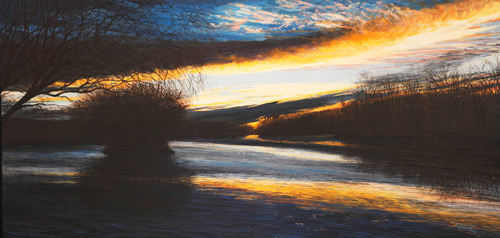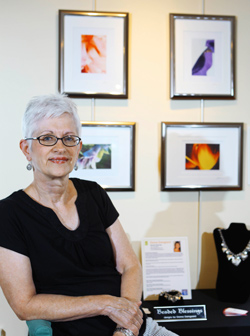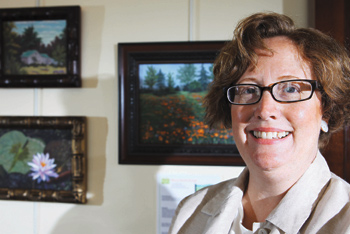 Ask glass artist Nate Dubbs what it is about his medium that’s so fascinating, and you’ll get a quick answer–it’s all about the process, he says. The art of glassblowing is centuries old, yet the process, which is almost mesmerizing to watch, has changed very little over time. “Plus there’s the element of danger since there’s fire involved,” Dubbs says. “And glass is sparkly and shiny, and people like things that are sparkly and shiny.”
Ask glass artist Nate Dubbs what it is about his medium that’s so fascinating, and you’ll get a quick answer–it’s all about the process, he says. The art of glassblowing is centuries old, yet the process, which is almost mesmerizing to watch, has changed very little over time. “Plus there’s the element of danger since there’s fire involved,” Dubbs says. “And glass is sparkly and shiny, and people like things that are sparkly and shiny.”
Dubbs is the Studio Manager of the hot glass shop at the Goggleworks Center for the Arts in Reading, one of the best glass facilities in the country and just one of the venues that are part of the PA Glass Trail which starts at the Center City Reading facility and crosses into the Lehigh Valley. Both casual art lovers and serious collectors are learning that Pennsylvania’s many cultural communities can easily match anything found in New York or Los Angeles. The numbers speak for themselves. Over $30,000 worth of works by glass artists were sold in 2009, according to Kristin Kramer, Director of Marketing and Development at Goggleworks.
 But it’s not just glass that’s putting Pennsylvania on the artistic radar. The Glass Trail is one of seven PA Artisan Trails that crisscross the highways and by-ways of Pennsylvania. The regional marketing initiative by the tourism office of Pennsylvania’s Department of Community and Economic Development (DCED) boasts the Pennsylvania Council on the Arts (PCA) as a partner. Now in its fourth year, the project supports partnerships between cultural tourism entities and lodging and hospitality venues that enhance destinations. The trails are a way to showcase art and artists in various regions of the state while providing opportunities for collaboration and enhancing cultural tourism efforts statewide.
But it’s not just glass that’s putting Pennsylvania on the artistic radar. The Glass Trail is one of seven PA Artisan Trails that crisscross the highways and by-ways of Pennsylvania. The regional marketing initiative by the tourism office of Pennsylvania’s Department of Community and Economic Development (DCED) boasts the Pennsylvania Council on the Arts (PCA) as a partner. Now in its fourth year, the project supports partnerships between cultural tourism entities and lodging and hospitality venues that enhance destinations. The trails are a way to showcase art and artists in various regions of the state while providing opportunities for collaboration and enhancing cultural tourism efforts statewide.
Although each is managed differently, all seven trails share a common goal–to bring art to the masses, only in the reverse. Art lovers can come to the doorstep of an artist’s studio and watch them at work, not to mention discover a unique gallery or a great place to eat or shop.
“DCED wanted Pennsylvania to be known as a place to go for art,” says Maggie Frank-Pascoe, Artisan Trails Manager at the Perry County Council for the Arts, who oversees the initiative. “And we (the participants) wanted to show that we have cool things.”
 Those cool things are found in the hot glass shops of glass artists, as well as the studios of fiber artists, metalworkers, and those who work in more “traditional” media like oils and acrylics, a number of galleries, restaurants, shops, and lodging establishments. The trails traverse all corners of Pennsylvania and have their own regional flair. Art Thrives on 45 travels along Route 45 from Danville to Spruce Creek. Rt. 15 ByWay of the Arts covers 180 miles of the state from north to south. The distinctive PA Glass Trail highlights the various glass artists along Route 22 from Reading to the Lehigh Valley. Handmade Along the Highway follows the historic Lincoln Highway and National Road on Routes 30 and 40 across the Southern portion of PA. The Route 6 Artisan Trail crosses the entire Northern Tier of Pennsylvania from Pike County to Erie County, heART of the Alleghenies spotlights the arts and artists in western Pennsylvania from Johnstown to Huntington, and the Pennsylvania Arts Experience encompasses the culturally diverse river valley regions of Southeastern Pennsylvania along routes 30 and 113. Regional Visitors Bureaus have come on board as partnering organizations and many offer getaway packages or special discounts.
Those cool things are found in the hot glass shops of glass artists, as well as the studios of fiber artists, metalworkers, and those who work in more “traditional” media like oils and acrylics, a number of galleries, restaurants, shops, and lodging establishments. The trails traverse all corners of Pennsylvania and have their own regional flair. Art Thrives on 45 travels along Route 45 from Danville to Spruce Creek. Rt. 15 ByWay of the Arts covers 180 miles of the state from north to south. The distinctive PA Glass Trail highlights the various glass artists along Route 22 from Reading to the Lehigh Valley. Handmade Along the Highway follows the historic Lincoln Highway and National Road on Routes 30 and 40 across the Southern portion of PA. The Route 6 Artisan Trail crosses the entire Northern Tier of Pennsylvania from Pike County to Erie County, heART of the Alleghenies spotlights the arts and artists in western Pennsylvania from Johnstown to Huntington, and the Pennsylvania Arts Experience encompasses the culturally diverse river valley regions of Southeastern Pennsylvania along routes 30 and 113. Regional Visitors Bureaus have come on board as partnering organizations and many offer getaway packages or special discounts.
Though there may not be an obvious connection between art and economic development, the reality is that the two rely heavily on each other–another message that the Trails’ members hope to promote.
“Having a creative arts community creates a vibrant community, which in turn attracts people to live here and spend money,” says Rob Evans, an artist with the PA Arts Experience. “The flourishing cultural entities help keep the local economy strong–they help bring people in. This is important from an economic standpoint. It’s important to keep our creative communities going–creativity is a driving force to keeping innovation moving.”
 The PA Art Experience currently has a roster of approximately 70 artists. Their orientation center in downtown Lancaster doubles as a gallery displaying work by Arts Experience members and a welcome center for tourists and locals looking to learn more about the area and the various Artisan Trails. The center’s concierge service is able to coordinate private tours of artists’ studios with interested visitors. Plans are underway to open a second center in York. For Evans, it’s just as important to educate local folks about the wide variety of art and artists in the area as it is for out-of-towners. The local art buying public is relatively small, which is why so many of the Trails depend on out-of-state buyers, particularly those from New York and Philadelphia.
The PA Art Experience currently has a roster of approximately 70 artists. Their orientation center in downtown Lancaster doubles as a gallery displaying work by Arts Experience members and a welcome center for tourists and locals looking to learn more about the area and the various Artisan Trails. The center’s concierge service is able to coordinate private tours of artists’ studios with interested visitors. Plans are underway to open a second center in York. For Evans, it’s just as important to educate local folks about the wide variety of art and artists in the area as it is for out-of-towners. The local art buying public is relatively small, which is why so many of the Trails depend on out-of-state buyers, particularly those from New York and Philadelphia.
“We’re hoping to draw in that serious art-buying audience from the bigger cities and have it dovetail with the local audience.,” says Evans. “We have a good local audience but we need the out-of-towners.”
The PA Arts Experience members have monthly exhibits and actively participate with the First Friday arts and culture celebrations in the different communities throughout their coverage area, which draw thousands of people in Lancaster alone. Evans says they are working on building more artists’ space in the orientation centers.
 “We try to link in to as many arts-related venues as we can,” he says, once again stressing the importance of partnerships. Even a few smaller hotels have caught the art bug. “We’ve had displays at the Lancaster Arts Hotel, which has a small gallery. We’ve also developed different getaway packages with them. As part of the package guests receive gift baskets with items by some of our artists.”
“We try to link in to as many arts-related venues as we can,” he says, once again stressing the importance of partnerships. Even a few smaller hotels have caught the art bug. “We’ve had displays at the Lancaster Arts Hotel, which has a small gallery. We’ve also developed different getaway packages with them. As part of the package guests receive gift baskets with items by some of our artists.”
Each trail has its own application process for new artists, but most require that applicants had their work juried at some point. The Arts Experience carries a yearly membership fee of $100. Frank-Pascoe, who manages the Rt. 15 trail, says that interested artists must be juried by their committee. Dubbs says that although most of the artists on the glass trail are involved in glass art in some fashion, it’s not a requirement to be part of the Route 22 trail.
As a member of the Artisan Trails, many Pennsylvania artists have had the opportunity to produce works for special occasions. Frank-Pascoe says that some of the Trail artists were commissioned to design and produce original pieces of art for the winners of the DCED Keystone Society for Tourism awards. She also cites the Gift of Art program, a roster of Trail artists from across Pennsylvania who are available for commissioned pieces in various mediums. Trail artists have produced one-of-a-kind glass Christmas ornaments, awards, and other pieces. The idea is to promote art wherever possible, and connect the artists with their customers, a concept Evans wholeheartedly supports.
“One of the reasons I got involved in founding this–is that the best sales I’ve had have come from direct contact with the buyer,” he says. “Many of the buyers I’ve spoken with have become longtime patrons. Having the customer speak directly with the artist is a really positive thing.”
Sara Hodon is a freelance writer who lives, works, and plays in Northeast PA. Learn more about her writing trials and triumphs on her blog. Send feedback here.
To receive Keystone Edge free every week, click here.
Photos:
The David Bottini painting “For Gabriel”
A Jason Lyons sculpture “Edgar,” made from disposed man-made objects, is part of the RT15 trail at the Landis House in Newport.
Gail Frank poses with her RT15 exhibit at the Landis House.
Mary Beth Brath and her Landis House exhibit.
A Donna Damgaard piece.
All Photographs by Mike Bupp
